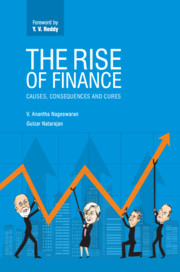5 - Consequences of Unconventional Monetary Policy
from Part B - The Consequences
Published online by Cambridge University Press: 02 May 2019
Summary
The Global Financial Crisis (GFC) of 2008 and the long and deep recession that followed it left a deep scar on all developed economies. After Lehman Brothers collapsed in September 2008, asset prices plunged and fear gripped the financial markets, forcing credit markets to dry up. Spooked by uncertainties about counter-party risks, lenders shut shop. The liquidity squeeze made even solvent institutions face the threat of insolvency.
Businesses, governments and households were left with bruised balance sheets. Credit markets froze, consumption and investment tanked, and economies contracted. Since governments had limited fiscal space to indulge in pump priming, the onus of containing the damage and leading the economic recovery efforts fell on the shoulders of central banks. Central banks assumed centre stage in this context (see Box 5.1).
Box 5.1 The false dawn of being the only game in town
The extraordinary monetary accommodation that started in the aftermath of the global financial crisis had a very justifiable rationale. The turmoil and its impact on the economy were devastating. Households, corporates and financial institutions needed the space and time to deleverage in a gradual and orderly manner. Keeping borrowing costs low was critical to this. Besides, this would also provide the time for governments to get their acts together with both fiscal policies as well as certain deep-rooted structural reforms so as to restore the economy to its pre-crisis levels.
Unfortunately, this had two flawed assumptions. One, governments would get their acts together. Two, we had to regain pre-crisis growth path. But both of these stood on flimsy foundations. Political considerations meant that governments were reluctant to bite the bullet with hard choices. In any case, governments in most developed economies had limited fiscal space available to prime the pump any more. In contrast, the likes of quantitative easing appeared a free lunch. And, as Larry Summers has written in the context of secular stagnation, the pre-crisis growth was itself built on unsustainable excesses. Regaining that was neither desirable nor possible without inflating more bubbles.
The resulting abdication by governments paved the path for central banks to assume leadership of the fight to restore growth. And the quest for pre-crisis growth necessarily meant prolonging the monetary accommodation and creating the conditions for another bubble.
- Type
- Chapter
- Information
- The Rise of FinanceCauses, Consequences and Cures, pp. 99 - 148Publisher: Cambridge University PressPrint publication year: 2019



